 W
WAbalone is a common name for any of a group of small to very large sea snails, marine gastropod molluscs in the family Haliotidae.
 W
WArgopecten purpuratus is an edible marine species of saltwater shellfish, a bivalve mollusk in the family Pectinidae.
 W
WThe blue mussel, also known as the common mussel, is a medium-sized edible marine bivalve mollusc in the family Mytilidae, the mussels. Blue mussels are subject to commercial use and intensive aquaculture. A species with a large range, empty shells are commonly found on beaches around the world.
 W
WBullacta exarata, common name the Korean mud snail, is a species of a sea snail or bubble snail, a marine gastropod mollusc in the family Haminoeidae, the bubble snails.
 W
WA cockle is an edible, marine bivalve mollusc. Although many small edible bivalves are loosely called cockles, true cockles are species in the family Cardiidae. True cockles live in sandy, sheltered beaches throughout the world. The distinctive rounded shells are bilaterally symmetrical, and are heart-shaped when viewed from the end. Numerous radial, evenly spaced ribs are a feature of the shell in most but not all genera.
 W
WThe common cockle is a species of edible saltwater clam, a marine bivalve mollusc in the family Cardiidae, the cockles. It is found in waters off Europe, from Iceland in the north, south into waters off western Africa as far south as Senegal. The ribbed oval shells can reach 6 centimetres (2.4 in) across and are white, yellowish or brown in colour. The common cockle is harvested commercially and eaten in much of its range.
 W
WThe common periwinkle or winkle is a species of small edible whelk or sea snail, a marine gastropod mollusc that has gills and an operculum, and is classified within the family Littorinidae, the periwinkles.
 W
WConch is a common name of a number of different medium- to large-sized sea snail or shells, generally those of large snails whose shell has a high spire and a noticeable siphonal canal.
 W
WConcholepas concholepas, the Chilean abalone, is a species of large edible sea snail, a marine gastropod mollusk. Despite the superficial resemblance, C. concholepas is not a true abalone, but a member of the family Muricidae, also known as murex snails or rock snails. This species is native to the coasts of Chile and Peru, where it is called loco or pata de burro and chanque.
 W
WCuttlefish or cuttles are marine molluscs of the order Sepiida. They belong to the class Cephalopoda, which also includes squid, octopuses, and nautiluses. Cuttlefish have a unique internal shell, the cuttlebone, which is used for control of buoyancy.
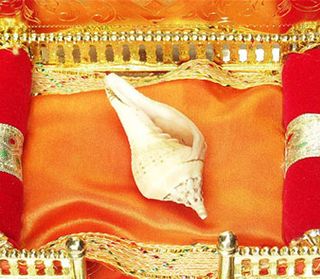 W
WDakshinavarti Shankh, is a sacred Hindu object otherwise known in English as a conch shell. This is the shell of a large sea snail from the Indian Ocean, but one that has the very rare reverse-turning spiral.
 W
WThe dredge oyster or Bluff oyster, Ostrea chilensis, known in Chile as ostra chilena, the Chilean oyster, is a species of marine bivalve mollusc in the family Ostreidae.
 W
WThe eastern oyster —also called Wellfleet oyster, in Wellfleet Mass., Atlantic oyster, Virginia oyster in Virginia, or American oyster. May also be called North Amerian East Coast Oyster or East Coast Oyster. Other notable Eastern appellations - Malpeque PEI, BluePoint. Chesapeake Bay Oyster, Apalachicola FLA, amongst others C. virginica —is a species of true oyster native to the eastern seaboard and Gulf of Mexico coast of North America. C. virginica ranges from Northern New Brunswick, is grown in all Maritime provinces of Canada Is grown in all eastern seaboard States, the States of The Gulf of Mexico, is found in parts of the West Indies, and into Brazil. It is also farmed in Puget Sound, Washington, where it is known as the Totten Inlet Virginica. and found in Pearl Harbour, Hawaii. Eastern oysters are and have been very popular commercially. Today, less than 1% of the population when the first 17th-century colonists arrived is thought to remain in the Chesapeake Bay and its tributaries.
 W
WThe Pacific geoduck is a species of very large saltwater clam in the family Hiatellidae. The common name is derived from a Lushootseed (Nisqually) word gʷídəq.
 W
WThe green ormer is a northeast Atlantic and Mediterranean species of sea snail, a coastal marine gastropod mollusc in the family Haliotidae, the abalones or ormer snails.
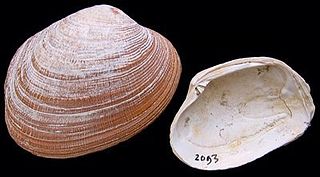 W
WThe grooved carpet shell, or Palourde clam, Ruditapes decussatus, or Venerupis decussatus, is a clam or bivalve mollusc in the family Veneridae. It is distributed worldwide and due to its ecological and economic interest has been proposed as a bioindicator.
 W
WThe pink abalone, scientific name Haliotis corrugata, is a species of large edible sea snail, a marine gastropod mollusk in the family Haliotidae, the abalones.
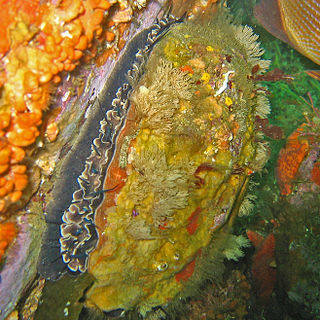 W
WHaliotis rufescens is a species of very large edible sea snail in the family Haliotidae, the abalones, ormer shells or paua. It is distributed from British Columbia, Canada, to Baja California, Mexico. It is most common in the southern half of its range.
 W
WThe Mediterranean mussel is a species of bivalve, a marine mollusc in the family Mytilidae. It is an invasive species in many parts of the world, and also an object of aquaculture.
 W
WMizuhopecten yessoensis is a species of scallop. Its name Yesso/Ezo refers to its being found north of Japan. They are marine bivalve mollusks in the family Pectinidae, the scallops.
 W
WMussel is the common name used for members of several families of bivalve molluscs, from saltwater and freshwater habitats. These groups have in common a shell whose outline is elongated and asymmetrical compared with other edible clams, which are often more or less rounded or oval.
 W
WMya truncata, common name the blunt gaper or truncate softshell, is a species of edible saltwater clam, a marine bivalve mollusk in the family Myidae.
 W
WMytilus coruscus, common name the Korean mussel or the hard-shelled mussel, is a species of mussel, a marine bivalve mollusc in the family Mytilidae. This species is heavily exploited as a food item via mariculture in Korea and in China.
 W
WThe octopus is a soft-bodied, eight-limbed mollusc of the order Octopoda. Around 300 species are recognised, and the order is grouped within the class Cephalopoda with squids, cuttlefish, and nautiloids. Like other cephalopods, the octopus is bilaterally symmetric with two eyes and a beak, with its mouth at the center point of the eight limbs. The soft body can rapidly alter its shape, enabling octopuses to squeeze through small gaps. They trail their eight appendages behind them as they swim. The siphon is used both for respiration and for locomotion, by expelling a jet of water. Octopuses have a complex nervous system and excellent sight, and are among the most intelligent and behaviourally diverse of all invertebrates.
 W
WThe development of octopus aquaculture, the farming of octopus, is being driven by strong market demands in the Mediterranean and in South American and Asian countries. Octopus live short lives, growing rapidly and maturing early. They typically reach two or three kilograms. There is little overlap between successive generations.
 W
WThe southern mud oyster, Australian flat oyster, native flat oyster, or angasi oyster, is endemic to southern Australia, ranging from Western Australia to southeast New South Wales and around Tasmania. Ostrea angasi superficially resembles Ostrea edulis and both species may be referred to with the name “flat oyster”. However, the two species do not occur naturally in the same geographic distribution.
 W
WOstrea edulis, commonly known as the European flat oyster, is a species of oyster native to Europe. In the British Isles, regional names include Colchester native oyster, mud oyster, or edible oyster. In France, Ostrea edulis are known as huîtres plates except for those that come from the Belon River estuary in Brittany, France, which are known as Belons.
 W
WThe Pacific oyster, Japanese oyster, or Miyagi oyster, is an oyster native to the Pacific coast of Asia. It has become an introduced species in North America, Australia, Europe, and New Zealand.
 W
WPaphies australis or pipi is a bivalve mollusc of the family Mesodesmatidae, endemic to New Zealand.
 W
WPaphies ventricosa, or toheroa, is a large bivalve mollusc of the family Mesodesmatidae, endemic to New Zealand.
 W
WPecten novaezelandiae, common name the New Zealand scallop, is a bivalve mollusc of the family Pectinidae, the scallops. Its name is sometimes found misspelt as Pecten novaezealandiae.
 W
WPerna canaliculus, the New Zealand green-lipped mussel, also known as the New Zealand mussel, the greenshell mussel, kuku, and kutai, is a bivalve mollusc in the family Mytilidae. P. canaliculus has economic importance as a cultivated species in New Zealand.
 W
WPerna perna, the brown mussel, is an economically important mussel, a bivalve mollusc belonging to the family Mytilidae. It is harvested as a food source but is also known to harbor toxins and cause damage to marine structures. It is native to the waters of Africa, Europe, and South America and was introduced in the waters of North America.
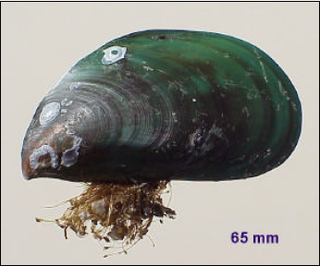 W
WPerna viridis, known as the Asian green mussel, is an economically important mussel, a bivalve belonging to the family Mytilidae. It is harvested for food but is also known to harbor toxins and cause damage to submerged structures such as drainage pipes. It is native in the Asia-Pacific region but has been introduced in the Caribbean, and in the waters around Japan, North America, and South America.
 W
WPinctada is a genus of saltwater oysters, marine bivalve mollusks in the family Pteriidae, the pearl oysters. These oysters have a strong inner shell layer composed of nacre, also known as "mother of pearl".
 W
WPinctada margaritifera, commonly known as the black-lip pearl oyster, is a species of pearl oyster, a saltwater mollusk, a marine bivalve mollusk in the family Pteriidae. This species is common in the Indo-Pacific within tropical coral reefs.
 W
WPlacopecten magellanicus, previously listed as Pecten tenuicostatus and as Pecten grandis and once referred to as the "giant scallop", common names Atlantic deep-sea scallop, deep sea scallop, North Atlantic sea scallop, American sea scallop, Atlantic sea scallop, or sea scallop, is a commercially important pectinid bivalve mollusk native to the northwest Atlantic Ocean.
 W
WPlebidonax deltoides or Donax deltoides is a small, edible saltwater clam or marine bivalve mollusc, endemic to Australia. It belongs to the family of either the Donacidae, or the related Psammobiidae. It is most widely known as the pipi in the eastern states of its native Australia. In South Australia, it is called the Coorong cockle, Goolwa cockle, or Goolwa pipi, for the region where it is most abundant, or by its Ngarrindjeri name, kuti. In south-eastern Queensland, it is often also known as eugarie or (y)ugari, a borrowing from the local Yugambeh and Ugarapul languages.
 W
WRuditapes largillierti is a saltwater clam, a marine bivalve mollusc in the family Veneridae, the Venus clams. They are moderately large for their genus, elongate and subrectangular, thick and solid, with smooth ventral margin.
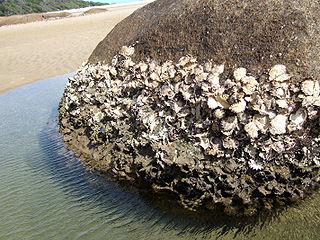 W
WSaccostrea glomerata, is an oyster species endemic to Australia and New Zealand. In Australia, it is known as the Sydney rock oyster and is commercially farmed. In New Zealand, where the species is not farmed, it is known as the New Zealand rock oyster or Auckland oyster. The species is closely related to Saccostrea cucullata, the hooded oyster, which is common on Indo-Pacific rocky shores.
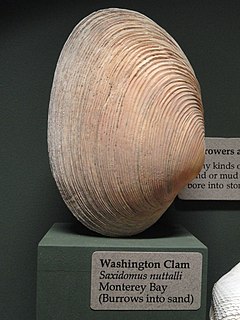 W
WSaxidomus nuttalli is a species of large edible saltwater clam, a marine bivalve mollusk in the family Veneridae, the venus clams. Common names include California butterclam and Washington clam.
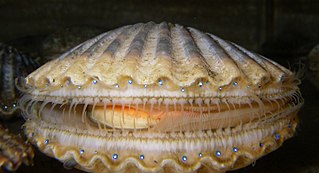 W
WScallop is a common name that is primarily applied to any one of numerous species of saltwater clams or marine bivalve mollusks in the taxonomic family Pectinidae, the scallops. However, the common name "scallop" is also sometimes applied to species in other closely related families within the superfamily Pectinoidea, which also includes the thorny oysters.
 W
WScallop aquaculture is the commercial activity of cultivating (farming) scallops until they reach a marketable size and can be sold as a consumer product. Wild juvenile scallops, or spat, were collected for growing in Japan as early as 1934. The first attempts to fully cultivate scallops in farm environments were not recorded until the 1950s and 1960s. Traditionally, fishing for wild scallops has been the preferred practice, since farming can be expensive. However worldwide declines in wild scallop populations have resulted in the growth of aquaculture. Globally the scallop aquaculture industry is now well established, with a reported annual production totalling over 1,200,000 metric tonnes from about 12 species. China and Japan account for about 90% of the reported production.
 W
WSepia prashadi, common name hooded cuttlefish, is a widely distributed species of cuttlefish. It has a thin, oval body and grows from 5 to 11 cm. The tips of the tentacles have a distinct club shape. S. prashadi is a migratory, demersal cuttlefish living in shallow waters at depths of approximately 40 to 50 metres. It is found in many locations including the east coast of Africa, around India, in the Red Sea, and Persian Gulf.
 W
WThe lightning whelk, scientific name Sinistrofulgur perversum, is an edible species of very large predatory sea snail or whelk, a marine gastropod mollusc in the family Busyconidae, the busycon whelks. This species has a left-handed or sinistral shell. It eats mostly bivalves.
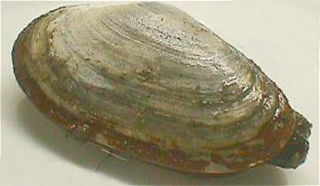 W
WSoft-shell clams or sand gaper, scientific name Mya arenaria, popularly called "steamers", "softshells", "piss clams", "Ipswich clams", or "Essex clams" are a species of edible saltwater clam, a marine bivalve mollusk in the family Myidae.
 W
WSquid are cephalopods in the superorder Decapodiformes with elongated bodies, large eyes, eight arms and two tentacles. Like all other cephalopods, squid have a distinct head, bilateral symmetry, and a mantle. They are mainly soft-bodied, like octopuses, but have a small internal skeleton in the form of a rod-like gladius or pen, made of chitin.
 W
WPaphies subtriangulata is a species of edible bivalve clam known as tuatua in the Māori language, a member of the family Mesodesmatidae and endemic to New Zealand. It is found on all three of the main New Zealand islands, buried in fine clean sand on ocean beaches.
 W
WWhelk is a common name that is applied to various kinds of sea snail. Although a number of whelks are relatively large and are in the family Buccinidae, the word whelk is also applied to some other marine gastropod species within several families of sea snails that are not very closely related.
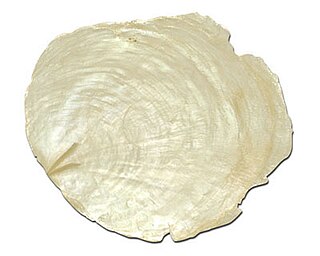 W
WThe windowpane oyster is a bivalve marine mollusk in the family of Placunidae. They are edible, but valued more for their shells. The shells have been used for thousands of years as a glass substitute because of their durability and translucence. More recently, they have been used in the manufacture of decorative items such as chandeliers and lampshades; in this use, the shell is known as the capiz or kapis. Capiz shells are also used as raw materials for glue, chalk and varnish.